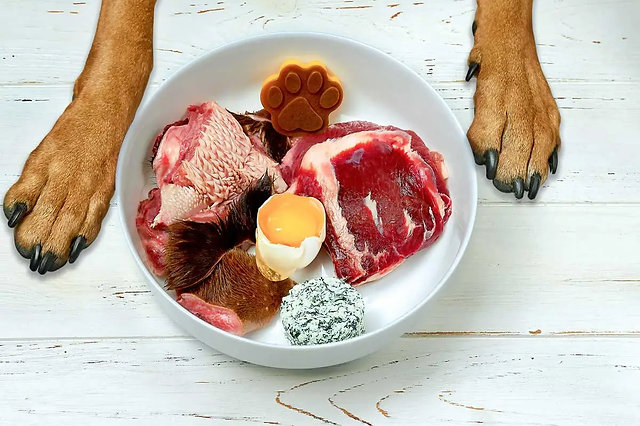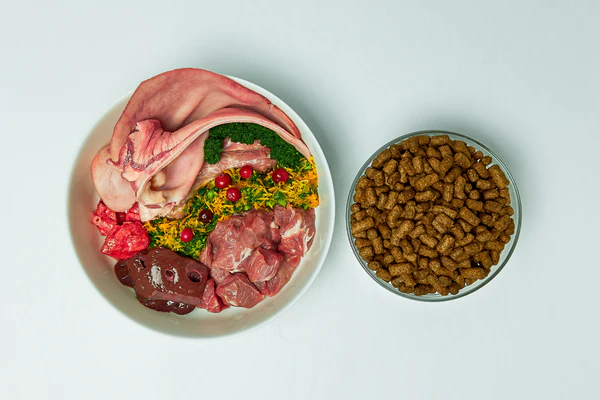Welcome to a blog dedicated to the well-being of our cherished four-legged companions – the Southernwind Families' guide to choosing between two prominent canine diets: the raw diet and the dry food diet. As the caretakers of our beloved dogs, it's only natural that we seek the best nourishment for their health and happiness. Join us on a journey of exploration as we delve into the intricacies of these dietary approaches, unveiling the unique benefits they offer to our Southernwind pups. Through expert insights and comprehensive analysis, we aim to equip you with the knowledge needed to make an informed decision that aligns with your dog's needs, preferences, and overall vitality. Whether you're considering transitioning to a raw diet to harness the power of natural ingredients or leaning towards the convenience of dry kibble, this blog will provide you with a deeper understanding of each option's merits. Let's embark on this nutritional expedition, dedicated to our Southernwind Families and our Dog friends, where every wagging tail and joyful bark is a testament to the care and consideration we pour into every aspect of our canine companions' lives.
*This Post may contain affiliated Links which means I may receive commissions at no cost to you if you make a purchase or choose to sign up for a Program through that link.
Both raw diets and high-quality kibble diets can offer benefits for dogs, but they have distinct characteristics and considerations. Here's a comparison of the benefits of each:
What is a raw food diet for dogs? And where does it come from?
While raw feeding has been a practice for many years for some dog owners, the main figurehead to place it at the forefront of the wider pet and pet food industry was Australian veterinarian, Dr Ian Billinghurst. In 1993, Dr Billinghurst first talked about the benefits of raw food in his book Give Your Dog A Bone, a theory based on what canines ate before domestication. Essentially, a cleaner, more natural diet. Think raw meats, vegetables, bones and zero unnecessary additives.
“Although the mind and the outward appearance of our modern dog has changed dramatically, the internal workings, including the entire digestive system, and the way food is utilised for growth, maintenance, repair and reproduction is fundamentally the same as its wild ancestors,” – Dr Ian Billinghurst.

While Dr Billinghurst created momentum and strong theory in his feeding principles through the BARF diet model, the term ‘raw diet’ has expanded since this time. Another popular version of a raw dog diet is RMBD (Raw Meaty Bones Diet).
If you search online, you’ll find a lot of different meal plans and creations based on raw feeding principles.
BARF and RMBD raw dog diets
The main difference between the BARF and RMBD raw dog diets is a slight adjustment in the ingredient inclusions. BARF is all about fresh, raw animal muscle meat, bones, offal, fruit and vegetables, along with other tasty nutrients like probiotics, kelp powder and cold-pressed ground flaxseed.
Alternatively, RMBD, which is similar and otherwise known as the Prey-Model (PMR), removes grains and vegetables because the premise is to feed your dog using the entire animal – giving your dog all the nurtrients required without any additions. This means the vegetables and fruits to balance a dog’s diet are in the stomach and digestive tract of the consumed animal, so they’re still apparent, just not added in separately and fresh. Furthermore, in line with the RMBD feeding, organs, muscles and bones are key ingredients. You can also now find commercially processed raw food options that are frozen or freeze-dried, providing variety within the raw offering. Just remember, the key principle of raw diets is to provide a healthier and more natural diet for your dog, without any unnecessary inclusions or preservatives.
*Note: Many vets back the research and findings of raw feeding, however, there are some who oppose it for safety risks and differing beliefs on what a dog’s diet can look like. It’s important to carefully select a diet for your dog after doing your own research, reading/understanding food labels, and discussing with a trusted vet.
**Raw Diet:**

1. **Nutritional Freshness:** Raw diets often consist of uncooked meats, bones, organs, and vegetables. Proponents argue that this maintains the nutritional value of the ingredients.
2. **Natural Ingredients:** Raw diets aim to mimic a dog's natural diet in the wild, emphasizing whole, unprocessed foods.
3. **Healthy Coat and Skin:** Advocates claim that raw diets can lead to healthier skin, shinier coats, and reduced shedding due to the inclusion of natural fatty acids.

4. **Improved Digestion:** Some dogs with sensitive stomachs or allergies might benefit from raw diets because they exclude common allergens like grains.
5. **Reduced Fillers:** Raw diets generally avoid fillers and additives commonly found in commercial kibble.
The breakdown of a raw diet meal plan
Due to the evolution of raw food diets for dogs, there is no cookie-cutter meal or ingredients list for raw feeding. However, here are the basics of what is included in a typical raw diet:
Raw Meats
Offal
Bone
Fruit and vegetables
Probiotics, herbs, fatty acids and prebiotics (alternative ingredients to balance nutrient profiles)

As with all dog diets, you need to ensure your pup is eating a complete and balanced one, offering your dog all the essentials to remain healthy. Acquiring an understanding of your dog’s daily nutrient requirements is very important, including the percentage of proteins, carbohydrates, vitamins and minerals.
Speak to your local vet for more information on your dog’s nutritional requirements and any other deficiencies you may need to address in their diet.
1. **Convenience:** Kibble is easy to store, handle, and portion. It doesn't require thawing or refrigeration like raw diets.
2. **Balanced Nutrition:** Many high-quality kibble brands are formulated by veterinary nutritionists to provide complete and balanced nutrition, making it easier to ensure your dog receives all necessary nutrients.
3. **Dental Health:** Some kibbles are designed to promote dental health by reducing tartar and plaque buildup as dogs chew.
4. **Variety and Formulas:** Premium kibbles offer various formulas for different life stages, sizes, and health needs, catering to a wide range of dogs.
5. **Safety and Quality Control:** Reputable kibble brands adhere to strict quality and safety standards, minimizing the risk of foodborne illnesses.
**Considerations:**
1. **Health Conditions:** If your dog has specific health conditions or allergies, consulting a veterinarian is crucial before switching to a new diet.
2. **Cost:** Raw diets can be expensive due to the quality of ingredients and potential need for supplements. Premium kibble can also come at a higher cost.
3. **Time and Preparation:** Raw diets require careful handling, preparation, and storage to ensure safety and nutritional balance.
4. **Transition Period:** Switching diets should be done gradually to avoid digestive upset.
5. **Dog Preference:** Some dogs may prefer the taste and texture of one diet over the other.
In the end, the choice between a raw diet and a high-quality kibble diet depends on your dog's individual needs, your preferences, and your ability to provide the necessary nutritional balance. Consulting with a veterinarian and conducting thorough research can help you make an informed decision that best suits your dog's well-being.








